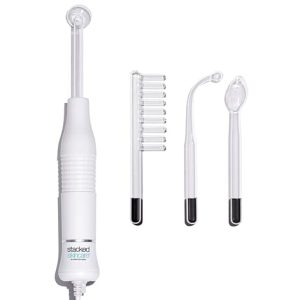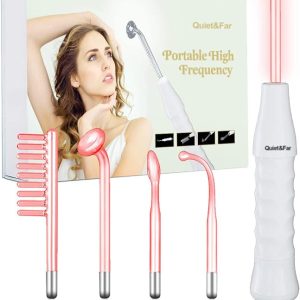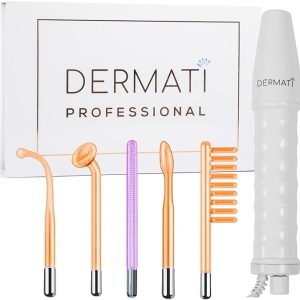Achieving a well-groomed and healthy beard involves more than just trimming and styling. High-frequency treatments have emerged as a potential game-changer in beard care routines.
By utilizing a high-frequency wand, which emits a mild electrical current, individuals can stimulate blood circulation, stimulate hair follicles, and promote optimal beard growth.
In this article, we delve into the benefits of high-frequency treatments for beards, the application process, precautions, and the potential transformation they can bring to your beard.


What Is High-Frequency Treatment?
High-frequency treatment is a skincare/haircare technique that uses a small electrical current to stimulate and rejuvenate the skin/scalp. It involves a high-frequency wand with different electrodes, each serving specific purposes like acne reduction, wrinkle smoothing, or hair growth.
The electrical current promotes blood circulation, boosts collagen production, and helps address various concerns.
How To Use High Frequency For Beard?
Here’s an effective method of using high frequency for beard:
| Step | Action |
|---|---|
| 1. Cleanse Beard | Use a beard-specific cleanser to remove any oils and impurities. This ensures a clean surface for the high-frequency treatment. Pat the beard dry with a clean towel. |
| 2. Select Electrode: | Opt for an electrode that suits your beard’s needs. The comb electrode is ideal for promoting circulation in facial hair, while the spoon electrode can target specific areas more precisely. |
| 3. Apply Conductive Gel: | Before starting the treatment, apply a thin layer of conductive gel to the beard area. This gel enhances the conductivity of the high-frequency wand and ensures a smoother application. |
| 4. Use Gentle Movements: | Move the high-frequency wand in gentle, circular motions across the beard. Focus on areas with sparse growth or patchiness for improved blood circulation and potential beard growth stimulation. |
| 5. Avoid Overstimulation: | Be cautious not to overstimulate the skin. Limit the time spent on each area to prevent irritation or discomfort. The goal is to enhance beard health without causing any side effects. |
| 6. Follow with Beard Oil: | After the high-frequency treatment, apply a nourishing beard oil. This helps maintain the health of both the skin and facial hair, keeping the beard soft and hydrated. |
| 7. Clean Electrode: | Clean the electrode and wand with a soft cloth or cotton pad using a mild disinfectant solution. Keeping the electrode clean ensures hygiene and prolongs the life of the device. |
| 8. Store Properly: | Store the high-frequency device in a cool, dry place to prevent any damage and ensure its effectiveness for future use. |
Can High Frequency Help Hair Growth?
High-frequency treatments have been suggested to aid in hair growth. The process involves using a high-frequency wand that emits a mild electrical current. This current stimulates the hair follicles, increases blood circulation in the scalp, and promotes the delivery of nutrients to the hair roots. The stimulation help strengthen hair and potentially encourage new growth.
However, it’s essential to note that individual responses to high-frequency treatments can vary. Consulting with a healthcare professional or dermatologist can provide personalized advice based on your specific hair concerns.
Benefits of Using High Frequency For Beard:
High-frequency treatments for beards can offer several benefits:
- Improved Blood Circulation
- Stimulation of Hair Follicles
- Reduced Beard Itch and Irritation
- Enhanced Absorption of Products
- Maintenance of Skin Health
- Beard Softening
It’s important to note that individual responses to high-frequency treatments can vary.
High Frequency for Beard Contraindications:
Using high frequency for beard is not suitable for everyone, high frequency should be avoided under these circumstances:
- Heart Conditions or Pacemaker Use
- Metal Implants
- Epilepsy or Seizure History
- Open Wounds or Infections
- Skin Sensitivity or Allergic Reactions
- Recent Chemical Peels or Dermabrasion


How Often To Use High Frequency For Beard?
The frequency of using high-frequency treatments for a beard can vary based on individual preferences and the specific needs of the beard.
However, a general recommendation is to use high-frequency treatments for a beard 1 to 3 times per week. This frequency allows for potential benefits in terms of improved blood circulation, stimulation of hair follicles, and overall beard health without overstimulating the skin.
It’s essential to monitor how your skin and beard respond to the treatments. If you notice any signs of irritation, such as redness or dryness, consider reducing the frequency or adjusting the intensity of the high-frequency sessions.
Aftercare:
After utilizing high-frequency treatments for your beard, it’s essential to follow a simple yet effective aftercare routine to maximize benefits and maintain skin health. Consider the following steps:
- Use Beard Oil: Enhance the nourishment of your facial hair by applying a beard oil. This helps keep your beard soft, manageable, and promotes overall beard health.
- Avoid Sun Exposure: Limit sun exposure immediately after the treatment, as your skin may be more sensitive.
- Stay Hydrated: Drink an ample amount of water to keep your skin hydrated from within, supporting its recovery and maintaining overall skin health.
- Avoid Harsh Products: Refrain from using harsh or abrasive skincare products for at least a day after the treatment to prevent irritation.
- Clean the Electrode: Wipe the electrode of the high-frequency wand with a soft cloth or cotton pad using a mild disinfectant solution to ensure cleanliness for the next use.
- Monitor Skin Reactions: Keep an eye on your skin for any unusual reactions, such as redness or irritation. If persistent, consult with a dermatologist for guidance.
By incorporating these aftercare practices into your routine, you can complement the benefits of high-frequency treatments, ensuring a well-nurtured beard and healthy skin.
Conclusion:
Incorporating high-frequency treatments 1 to 3 times per week can enhance beard health by promoting blood circulation and stimulating hair follicles. Pay attention to individual skin responses, adhere to device instructions, and consult with a dermatologist if needed.
With cautious and consistent use, high-frequency treatments can contribute to a softer, healthier beard, providing a valuable addition to your grooming routine.






